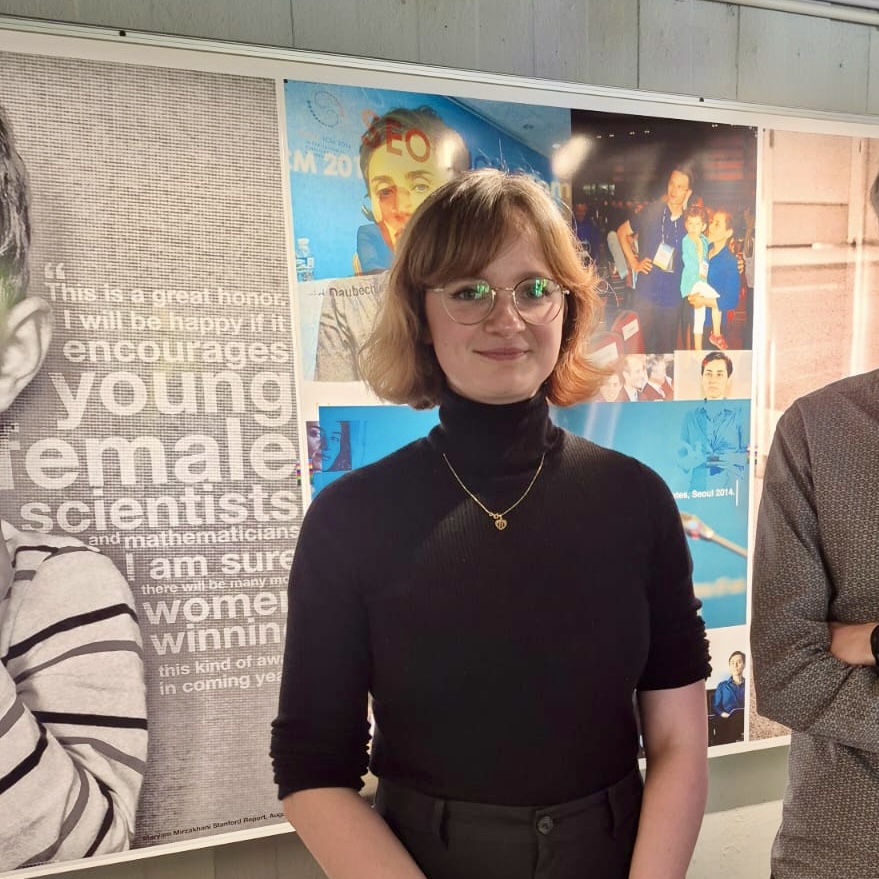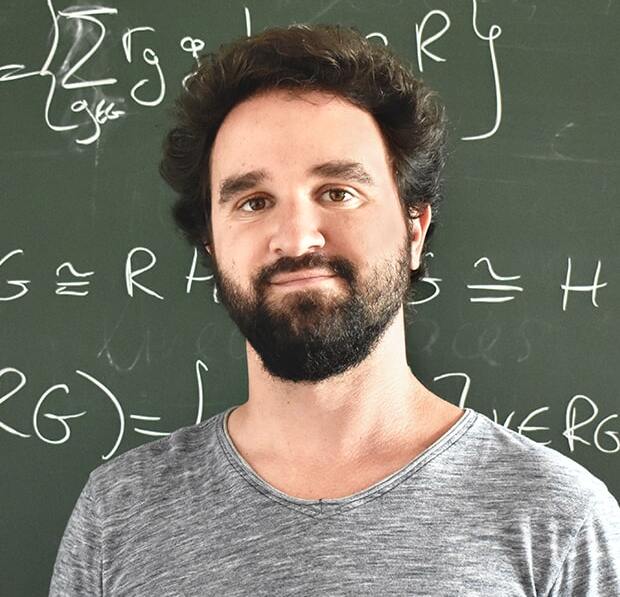-
On integral decomposition of unipotent elements in integral group rings, Proc. Roy. Soc. Edinburgh Sect. A (2025), 60pp
joint with L. Margolis
arXiv |
Journal |
▸ Abstract
-
▸ Jespers and Sun conjectured that if a finite group $G$ has the property ND, i.e. for any nilpotent element $n$ in the integral group ring $\mathbb{Z}G$ and any primitive central idempotent $e \in \mathbb{Q}G$ one still has $ne \in \mathbb{Z}G$, then at most one of the simple components of the group algebra $\Q G$ has reduced degree bigger than $1$. With the exception of one very special series of groups we are able to answer their conjecture, showing that it is true --- up to exactly one exception. To do so we first describe groups with the so-called SN property which was introduced by Liu and Passman in their investigation of the Multiplicative Jordan Decomposition for integral group rings. We then study further objects connected to the property ND. This concerns on one hand a certain section of the unit group of $\mathbb{Z} G$ which measures how far $G$ is from having ND and about which Jespers and Sun posed two further questions which we answer. On the other hand we introduce two properties which appeared naturally in these investigations: one is purely representation-theoretic, while the other can be regarded as indicating that it might be hard to decide ND. Among others we show these two notions are equivalent for groups with SN.
-
Units of twisted group rings and their correlations to classical group rings, Adv. Math., 458 (2024), 81 pp
joint with E. Jespers and Ofir Schnabel
arXiv |
Journal |
▸ Abstract
-
▸ This paper contributes to the classical problem of extracting properties of a finite group $G$ from the ring isomorphism class of its integral group ring $\mathbb{Z} G$. This problem is considered via describing the unit group $\mathcal{U}( \mathbb{Z} G)$ generically for a finite group. Concretely we obtain a new generic construction of units in $SL_1(\mathbb{Z} G)$ which are proven to extend, for natural classes of groups, with infinite index the current known constructions. Moreover this new construction also exhibits new properties, such as providing generically free subgroups of large rank. As an application we answer positively for several classes of groups the strongest form of the recent conjectures on the rank and torsion of the abelianisation $\mathcal{U}(\mathbb{Z} G)^{ab}$. To obtain all this, we investigate the group ring $R \Gamma$ of an extension $\Gamma$ of some normal subgroup $N$ by a group $G$, over a domain $R$. More precisely, we obtain a direct sum decomposition in terms of various twisted group rings of $G$ and concrete information on the kernel and cokernel of the associated projections. Along the way we also launch the investigations of the unit group of twisted group rings and of $\mathcal{U}( R\Gamma)$ via twisted group rings.
-
Abelianization and fixed point properties of linear groups and units in integral group rings, Math. Nachr., 296 (2023), no. 1, 8–56
joint with A. Bächle, E. Jespers, A. Kiefer and D. Temmerman
arXiv |
Journal |
▸ Abstract
-
▸ Fixed point properties and the abelianization of arithmetic subgroups $\Gamma$ of $\operatorname{SL}_n(D)$ and its elementary
subgroup $\operatorname{E}_n(D)$ are well understood except in the degenerate case of lower rank, i.e. $n=2$ and $\Gamma = \operatorname{SL}_2(\mathcal{O})$
with $\mathcal{O}$ an order in a division algebra $D$ with a finite number of units. In this setting we determine Serre's property
$\operatorname{FA}$ for $\operatorname{E}_2(\mathcal{O})$ and its subgroups of finite index. We construct a generic and computable exact sequence
describing its abelianization, affording a closed formula for its $\mathbb{Z}$-rank. Thenceforth, we investigate applications in
integral representation theory of finite groups. We obtain a characterization of when the unit group $\mathcal{U}(\mathbb{Z}G)$ of
the integral group ring $\mathbb{Z} G$ satisfies Kazhdan's property $(\operatorname{T})$, both in terms of the finite group $G$ and
in terms of the simple components of the semisimple algebra $\mathbb{Q}G$. Furthermore, it is shown that for $\mathcal{U}( \mathbb{Z} G)$
this property is equivalent to a hereditary version of property $\operatorname{FA}$, denoted $\operatorname{HFA}$, and even the significantly
weaker property $\operatorname{FAb}$ (i.e. every subgroup of finite index has finite abelianization). A crucial step for this is a reduction to
arithmetic groups $\operatorname{SL}_n(\mathcal{O})$ and finite groups $G$ which have the so-called cut property.
For such groups $G$ we describe the simple epimorphic images of $\mathbb{Q} G$.
-
Cluster Ensembles and the Fock-Goncharov duality conjectures, Oberwolfach Reports , no. 45 (2023), 36-39
Journal |
-
A dichotomy for integral group rings via higher modular groups as amalgamated products, J. Algebra 604 (2022), 185–223
joint with A. Bächle, E. Jespers, A. Kiefer and D. Temmerman
arXiv |
Journal |
▸ Abstract
-
▸ We show that $\mathcal{U}(\mathbb{Z}G)$, the unit group of the integral group ring $\mathbb{Z} G$, either
satisfies Kazhdan's property (T) or is, up to commensurability, a non-trivial amalgamated product, in case $G$ is a finite group
satisfying some mild conditions. Crucial in the proof is the construction of amalgamated decompositions of the elementary group $\operatorname{E}_2(\mathcal{O})$,
where $\mathcal{O}$ is an order in a rational division algebra. A major step is to introduce subgroups $\operatorname{E}_2(\Gamma_n(\mathbb{Z}))$ inside the
so-called higher modular groups $\operatorname{SL}_+(\Gamma_n(\mathbb{Z}))$, which are discrete subgroups of certain $2 \times 2$ matrix groups with
entries in a Clifford algebra. The groups $\operatorname{E}_2(\Gamma_n(\mathbb{Z}))$ mimic the elementary groups in linear groups over rings. We prove that
$\operatorname{E}_2(\Gamma_n(\mathbb{Z}))$ has in general a non-trivial decomposition as a free product with amalgamated subgroup $\operatorname{E}_2(\Gamma_{n-1}(\mathbb{Z}))$.
From this we obtain that also the higher modular groups do have a very clearly structured amalgam decompositions in low dimensions.
-
Codimension Growth of Lie algebras with a generalized action,
Proc. Amer. Math. Soc. , 150 (2022), no. 7, 2741–2754
arXiv |
Journal |
▸ Abstract
-
▸ Let $L$ be a finite dimensional Lie $F$-algebra endowed with a generalized action by an associative algebra $H$.
We investigate the exponential growth rate of the sequence of H-graded codimensions $C_n^H(L)$ of $L$ which is a measure for the number
of non-polynomial $H$-identities of $L$. More precisely, we construct the first example of an $S$-graded Lie algebra having a non-integer,
even irrational, exponential growth rate $\lim_{n \rightarrow \infty} \sqrt[n]{c_n^S(L)}$. Hereby $S$ is a semigroup and an exact value is given. On the other hand,
returning to general $H$, if $L$ is semisimple and also semisimple for the $H$-action we prove the analog of Amitsur's conjecture (i.e. $\lim_{n \rightarrow \infty} \sqrt[n]{c_n^H(L)} \in \mathbb{Z}$).
Moreover if $H=FS$ is a semigroup algebra the semisimplicity on $L$ can be dropped which is in strong contract to the associative setting.
-
A glimpse into the Asymptotics of polynomial identities, Nieuw Arch. Wiskd. (5) 18 (2017), no. 1, 60-64
Journal |
▸ Abstract
-
▸ This a survey paper on the most significant results in the combinatorial theory of polynomial identities.
-
Free products in the unit group of the integral group ring of a finite group, Proc. Amer. Math. Soc. 145 (2017), no. 7, 2771-2783
joint with E. Jespers and D. Temmerman
arXiv |
Journal |
▸ Abstract
-
▸ Let $G$ be a finite group and let $p$ be a prime. We continue the search for generic constructions of free products and
free monoids in the unit group $\mathcal{U}(\mathbb{Z}G)$ of the integral group ring $\mathbb{Z} G$. For a nilpotent group $G$ with a
non-central element $g$ of order $p$, explicit generic constructions are given of two periodic units $b_1$ and $b_2$ in
$\mathcal{U}(\mathbb{Z}G)$ such that $\langle b_1 , b_2\rangle =\langle b_1\rangle \star \langle b_2 \rangle =\mathbb{Z}_p \star \mathbb{Z}_{p}$,
a free product of two cyclic groups of prime order. Moreover, if $G$ is nilpotent of class $2$ and $g$ has order $p^n$, then also concrete
generators for free products $\mathbb{Z}_{p^k} \star \mathbb{Z}_{p^m}$ are constructed (with $1\leq k,m\leq n $). As an application, for finite nilpotent
groups, we obtain earlier results of Marciniak-Sehgal and Goncalves-Passman. Further, for an arbitrary finite group $G$ we give
generic constructions of free monoids in $\mathcal{U}(\mathbb{Z}G)$ that generate an infinite solvable subgroup.
-
A reduction theorem for $\tau$-rigid modules, Math. Z. (2018), 1-37
joint with F. Eisele and T. Raedschelders
arXiv |
Journal (open access) |
GAP-code |
▸ Abstract
-
▸ We prove a theorem which gives a bijection between the support $\tau$-tilting modules over a given finite-dimensional algebra
A and the support τ-tilting modules over $A/I$, where $I$ is the ideal generated by the intersection of the center of $A$ and the radical of $A$.
This bijection is both explicit and well-behaved. We give various corollaries of this, with a particular focus on blocks of group rings of
finite groups. In particular we show that there are $\tau$-tilting finite wild blocks with more than one simple module. We then go on to classify
all support $\tau$-tilting modules for all algebras of dihedral, semidihedral and quaternion type, as defined by Erdmann, which include all tame
blocks of group rings. Note that since these algebras are symmetric, this is the same as classifying all basic two-term tilting complexes,
and it turns out that a tame block has at most $32$ different basic two-term tilting complexes. We do this by using the aforementioned
reduction theorem, which reduces the problem to ten different algebras only depending on the ground field $k$, all of which happen to be
string algebras. To deal with these ten algebras we give a combinatorial classification of all $\tau$-rigid modules over
(not necessarily symmetric) string algebras
-
The Polynomial Part of the Codimension Growth of Affine PI algebras, Adv. Math. 309 (2017), 487-511.
joint with E.Aljadeff and Y.Karasik
arXiv |
Journal |
▸ Abstract
-
▸ Let $F$ be a field of characteristic zero and $W$ be an associative affine $F$-algebra satisfying a polynomial identity (PI).
The codimension sequence associated to $W$, $c_n(W)$, is known to be of the form $\theta(cn^td^n)$, where $d$ is the well known (PI) exponent of $W$.
In this paper we establish an algebraic interpretation of the polynomial part (the constant $t$) by means of Kemer's theory. In particular,
we show that in case $W$ is a basic algebra, then $t=\frac{d-q}{2}+s$, where $q$ is the number of simple component in $W/J(W)$ and $s+1$ is
the nilpotency degree of $J(W)$. Thus proving a conjecture of Giambruno.
-
Semigroup graded algebras and graded PI-exponent, Israel J. Math. 220 (2017), no. 1, 387-452.
joint with A.Gordienko and E. Jespers
arXiv |
Journal |
▸ Abstract
-
▸ Let $S$ be a semigroup. We study the structure of graded-simple $S$-graded algebras $A$ and the exponential rate
$\operatorname{PIexp}^{S}(A) := \lim\limits_{n \rightarrow \infty} \sqrt[n]{c_n^{S}(A)}$ of growth of
codimensions $c_n^{S}(A)$ of their graded polynomial identities. This is of great interest since such algebras
can have non-integer $\operatorname{PIexp}^{S}(A)$ despite being finite dimensional and associative. In addition, such algebras
can have a non-trivial Jacobson radical $J(A)$. All this is in strong contrast with the case when $S$ is a group since in the group case
$J(A)$ is trivial, $\operatorname{PIexp}^{S}(A)$ is always integer and, if the base field is algebraically closed, then
$\operatorname{PIexp}^{S}(A)$ equals $\operatorname{dim} A$. Without any restrictions on the base field $F$, we classify graded-simple $S$-graded
algebras $A$ for a class of semigroups $S$ which is complementary to the class of groups. We explicitly describe the structure of $J(A)$ showing that $J(A)$
is build up of pieces of a maximal $S$-graded semisimple subalgebra of $A$ which turns out to be simple. When $F$ is algebraically closed,
we get an upper bound for $\mathop{\overline\lim}_{n\to\infty}\sqrt[n]{c_n^{S}}(A)$. If $A/J(A)\cong M_2(F)$
and $S$ is a right zero band, we show that this upper bound is sharp and $\operatorname{PIexp}^{S\text{-}\mathrm{gr}}(A)$ indeed exists.
In particular, we present an infinite family of graded-simple algebras $A$ with arbitrarily large non-integer
$\operatorname{PIexp}^{S}(A)$.
-
$\mathbb{Z}$Sn-modules and polynomial identities with integer coefficients, Int. J. Algebra Comput. 23 (2013), no. 8, 1925-1943.
joint with A.Gordienko
arXiv |
Journal |
▸ Abstract
-
▸ We show that, like in the case of algebras over fields, the study of multilinear polynomial identities of unitary rings can be
reduced to the study of proper polynomial identities. In particular, the factors of series of $\mathbb{Z}S_n$-submodules in the
$\mathbb{Z}S_n$-modules of multilinear polynomial functions can be derived by the analog of Young's (or Pieri's) rule from the factors of
series in the corresponding $\mathbb{Z}S_n$-modules of proper polynomial functions. As an application, we calculate the codimensions and a
basis of multilinear polynomial identities of unitary rings of upper triangular $2\times 2$ matrices and infinitely generated Grassmann
algebras over unitary rings. In addition, we calculate the factors of series of $\mathbb{Z}S_n$-submodules for these algebras. Also we
establish relations between codimensions of rings and codimensions of algebras and show that the analog of Amitsur's conjecture holds
in all torsion-free rings, and all torsion-free rings with $1$ satisfy the analog of Regev's conjecture.
-
Primitive Central Idempotents of Rational Group Algebras, J. Algebra Appl. 12 (2013), no. 1, 125-130.
arXiv |
Journal |
▸ Abstract
-
▸ We give a description of the primitive central idempotents of the rational group algebra $\mathbb{Q}G$ of a finite group $G$. Such a
description is already investigated by Jespers, Olteanu and del Río, but some unknown scalars are involved. Our description also gives
answers to their questions.












